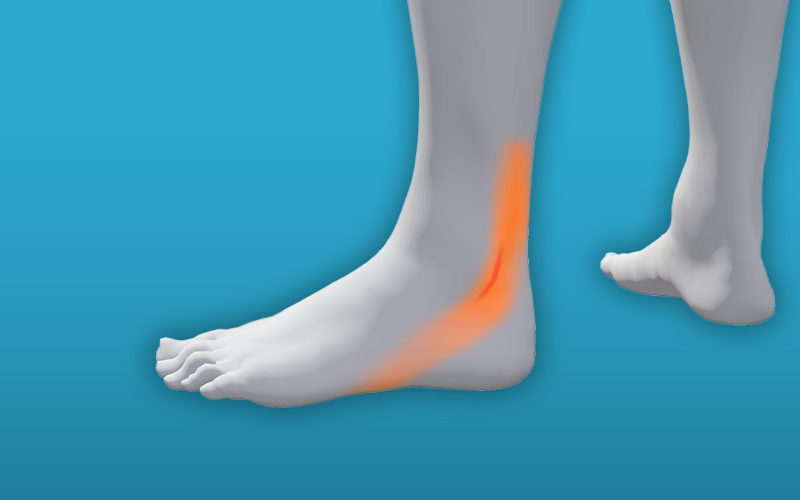
Peroneal tendinopathy
What is it?
The peroneal muscles are made up of peroneal longus and peroneal brevis. They are found on the outside of the lower part on the leg. The peroneal tendon is a strong tendon that runs down the side on the ankle. The muscle and tendon acts together to move the ankle outwards (eversion) and assist the Achilles tendon in pointing the foot down (plantar flexion). It is also very important in stabilising the foot and ankle when weight bearing.
Peroneal tendinopathy is not that common, however when occurs it does cause significant discomfort while weight bearing. It can occur due to trauma e.g. spraining your ankle. It can also be due to an overload of the tendon. Poor fitting footwear is also a common cause of pain.
Pain is usually felt on the outside of the ankle and foot.
Picture: right ankle with the location of the peroneal muscles and tendons in red shading.
Pain can be felt anywhere along this area.
More commonly pain is felt towards the ankle and foot.

How to manage it
Majority of patient settle down on its own. By following the simple steps you can try managing this at home. Very few need any medical invention.
Modifying activities
Initially resting the foot by reducing weight bearing activity can be helpful in reducing pain and inflammation as well as the use of ice with other simple pain medication
Simple painkillers
Painkillers like paracetamol will ease the pain, but need to be taken regularly in order to control the pain. Always follow the instructions on the packet.
Anti-inflammatories like ibuprofen can help with swelling, and therefore help you move more freely. Topical (applied directly on the affected body area) anti-inflammatories are recommended initially. Follow the instructions on the packet and discuss using them safely with a pharmacist, especially if you have any underlying health conditions
However, you should not take ibuprofen for 48 hours after an initial injury as it may slow down healing.
Up to date guidelines can be found on the NHS website:
Other medicines can help to reduce inflammation, swelling and pain. You should discuss this with your GP if the simple pain relief advice does not help or if you are needing to take ibuprofen for more than 10 days.
Ice or heat therapy
Heat may be helpful in the form of a hot water bottle, wheat pack or hot shower. This can help to relax the muscles around your ankle and may allow exercises to be more effective.
For ice therapy use a damp cloth containing an icepack (or bag of frozen peas) over the top of the painful area to help numb the pain. Leave it on for up to 20 minutes and use up to three times a day.
- You should be cautious using these treatments if you have altered skin sensation or circulatory problems.
- Check the skin regularly during and after the ice pack application
- Stop if there is excessive pain, numbness or tingling
- Do not put ice directly on to the skin as this may cause a burn.
Excercise
It is important that exercises are performed to help your recovery. Start gradually and build up the exercises. Do not continue exercises if pain increases or condition worsens. Speak to GP or self-refer to physiotherapy for further advice.
Tie an exercise band around a stable object, and tie the other end around the outside of your foot. Move your foot outwards and upwards against the resistance of the band.

Reducing the tightness in you calf muscles can help the management of peronena tendon pain.
Stand facing a wall, with your hands resting on the wall. Move one leg forwards and gently bend your knee, this will be the passive leg and just there for support. The leg you will be stretching will remain straight with your heel on the ground. You should feel a stretch to the leg at the back, in the calf muscle (known as the gastrocnemius).

Stand facing a wall, place one leg in front of you and your hands flat against the wall. Keep both heels on the ground, and your front knee bent. Push your front knee forward towards the wall to feel a stretch in the lower back part of the front leg (bottom of the calf muscle, known as the soleus).

Strengthening exercises
Strengthening of the muscles around ankle has been found helpful. Try some heel raises, as shown below, as your pain allows. Start with a small number and gradually build up.
Heel and toe tapping 3 minutes 3 times / day 20 second hold three times 3 minutes 3 times / day.

Stand tall, with your weight distributed evenly on both feet, and take support if needed.
Rise up onto your toes and in a controlled manner return to the starting position.
Repeat 10 times x 3.

Improving balance can also help strengthen and improve your condition.
This can be done holding on to something to start with, transfer weight from one foot to another. Then try doing this without support.
Progress the exercise to balancing on one foot.
To increase difficulty close eyes or place arms above head/ throw a ball against a wall.

Balance board exercises
It is important to regain confidence and strength in your ankle. When the above exercises are easy to do you may find wobble board exercises beneficial for your recovery. You should speak with a healthcare professional before trying these exercises.

Footwear
Modifications to your footwear with the use of simple insoles and supportive shoes or trainers will help to reduce the loading of the tendon.
See the footwear section for further advice.
Physiotherapy
If you find that you are not improving, some advice or treatment from a physiotherapist can be helpful in managing ankle pain. Click here to self-refer to a physiotherapist.
